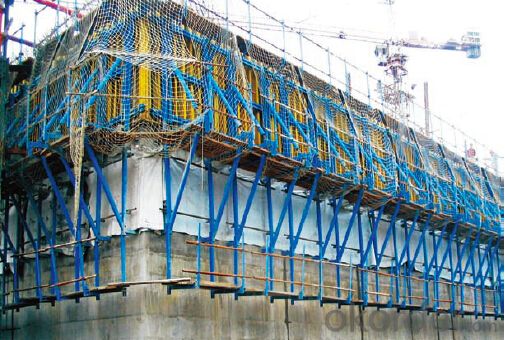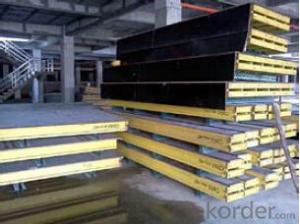Single Side Climbing Bracket for Formwork and Scaffolding Systems
- Loading Port:
- Tianjin
- Payment Terms:
- TT OR LC
- Min Order Qty:
- 50 m²
- Supply Capability:
- 1000 m²/month
OKorder Service Pledge
OKorder Financial Service
You Might Also Like
Single-side Climbing Bracket SCB180:
With CNBM SCB 180 climbing systems, the loads from the fresh concrete pressure are
transferred through the brackets by means of V-strongbacks and compression braces into the
scaffold anchors.
Typical applications for the SCB 180 are dams, locks, cooling towers, pier heads, tunnels, and
bank vaults.
The formwork is simply tilted backwards when striking takes place. The 1.80 m wide bracket
requires only a minimum of space.
Characteristics:
◆ Economical and safe anchoring
The M30/D20 climbing cones have been designed especially for single-sided concreting using
SCB180 in dam construction, and to allow the transfer of high tensile and shear forces into the still
fresh, unreinforced concrete. Without wall-through tie-rods, finished concrete is perfect.
◆ Stable and cost-effective for high loads
generous bracket spacings allow large-area formwork units with optimal utilization of the bearing
capacity. This leads to extremely economical solutions.
◆ Simple and flexible planning
With SCB180 single-sided climbing formwork, circular structures can also be concreted without
undergoing any large planning process. Even use on inclined walls is feasible without any special
measures because additional concrete loads or lifting forces can be safely transferred into the
structure.


- Q: Can steel formwork be used for curved or irregular shapes?
- Yes, steel formwork can be used for curved or irregular shapes. Its flexibility allows it to be easily shaped and adjusted to create the desired form.
- Q: Can steel formwork be used for curved or complex shapes?
- Yes, steel formwork can be used for curved or complex shapes. Steel is a flexible and durable material that can be easily shaped and molded to fit various designs. It offers the advantage of being able to create intricate and customized formwork systems that can be used for a wide range of applications, including curved or complex shapes. The strength and stability of steel also ensure that the formwork remains in place during the pouring and curing of concrete, allowing for precise and accurate construction. Additionally, steel formwork can be reused multiple times, making it a cost-effective option for projects that require curved or complex shapes.
- Q: Can steel formwork be used for both small and large-scale concrete placements?
- Yes, steel formwork can be used for both small and large-scale concrete placements. Steel formwork has high strength and durability, allowing it to withstand the pressure exerted by the concrete during the pouring process. Its versatility and reusability make it suitable for various construction projects, regardless of their size.
- Q: How does steel formwork contribute to the overall strength and stability of a structure?
- The construction industry heavily relies on steel formwork to enhance the strength and stability of structures. This crucial component plays a vital role in maintaining the integrity and durability of buildings by providing a dependable support system during the process of pouring concrete. To begin with, steel formwork possesses exceptional strength and rigidity, enabling it to withstand the immense weight and pressure exerted by wet concrete. Its sturdy construction ensures that it does not deform or collapse under these heavy loads, thereby preventing any potential damage or compromise to the stability of the structure. Furthermore, steel formwork provides an accurate and precise framework for pouring concrete. The dimensional stability of steel ensures that the formwork retains its shape and dimensions throughout the construction process. This accuracy is crucial in achieving a structurally sound and level structure, as any misalignment or irregularity in the formwork can lead to uneven distribution of concrete and weaken the overall strength of the building. Moreover, steel formwork exhibits excellent resistance to moisture and corrosion. This resistance guarantees that the formwork remains intact and structurally sound, even in environments with high humidity or exposure to water. By preventing rust and deterioration, steel formwork maintains its strength and stability over time, thus contributing to the long-term durability of the structure. Another notable advantage of steel formwork is its reusability. Unlike traditional wooden formwork, steel formwork can be reused multiple times without compromising its structural integrity. This reusability not only reduces construction costs but also minimizes waste and environmental impact. The ability to reuse steel formwork ensures that subsequent concrete structures maintain consistent strength and stability, without any compromise in quality. In conclusion, steel formwork is an indispensable element in the construction industry, significantly enhancing the strength and stability of structures. Its exceptional strength, dimensional accuracy, resistance to moisture and corrosion, and reusability make it an ideal choice for ensuring the integrity and durability of concrete structures. By providing a robust and reliable support system, steel formwork plays a pivotal role in the construction of safe and long-lasting buildings.
- Q: How does steel formwork contribute to the overall aesthetics of a structure?
- Steel formwork can contribute to the overall aesthetics of a structure by providing a smooth and clean finish to concrete surfaces. Its rigid and durable nature allows for precise shaping and detailing, resulting in sharp edges and smooth surfaces that enhance the visual appeal of a building. Additionally, steel formwork offers flexibility in design, enabling architects to create complex and unique shapes, adding an artistic touch to the structure.
- Q: How does steel formwork handle concrete temperature differentials?
- Steel formwork is known for its strength and durability, which allows it to effectively handle concrete temperature differentials. The thermal conductivity of steel helps in evenly distributing the heat or cold generated by the concrete during the curing process. This prevents the formation of cracks or other structural issues that can occur due to uneven temperature distribution. Additionally, steel formwork provides stability and rigidity, ensuring that the concrete maintains its desired shape and strength even when exposed to varying temperatures.
- Q: What are the common safety certifications for steel formwork?
- There are several common safety certifications for steel formwork used in construction projects. These certifications ensure that the steel formwork meets specific safety standards and regulations. One of the most well-known certifications is the OSHA (Occupational Safety and Health Administration) certification. This certification ensures that the steel formwork complies with the safety regulations set forth by OSHA. It covers various aspects such as stability, load-bearing capacity, and structural integrity. Another widely recognized certification is the ANSI (American National Standards Institute) certification. ANSI provides standards for construction equipment and materials, including steel formwork. This certification ensures that the formwork meets the necessary safety requirements, including strength, durability, and stability. The European standard EN 12812 is also an important certification for steel formwork used in Europe. It sets out the requirements for formwork systems and verifies their safety and performance. This certification covers aspects such as load-bearing capacity, stability, and safety factors. Additionally, the International Organization for Standardization (ISO) provides certifications related to steel formwork safety. The ISO 9001 certification ensures that the manufacturer has a quality management system in place, while the ISO 45001 certification focuses on occupational health and safety management systems. Other specific certifications may be required depending on the country or region. For example, in the United Kingdom, the British Standards Institution (BSI) certification may be necessary. Overall, these safety certifications for steel formwork provide assurance to construction professionals that the formwork they are using meets the necessary safety standards and regulations. It is essential to ensure that the steel formwork used on construction sites holds these certifications to prevent accidents, ensure worker safety, and maintain the structural integrity of the formwork.
- Q: How does steel formwork affect the construction schedule?
- Steel formwork can greatly affect the construction schedule in a positive way. Due to its strength and durability, steel formwork allows for faster and more efficient construction processes. This results in reduced construction time and faster completion of the project. Additionally, steel formwork is reusable, which further saves time and resources as it can be quickly dismantled and used for future construction projects.
- Q: What are the different types of joints used in steel formwork?
- There are several different types of joints commonly used in steel formwork for construction projects. These joints are designed to provide stability and ensure the proper alignment of the formwork system. 1. Butt Joint: The butt joint is the most basic type of joint used in steel formwork. It is formed by placing two formwork panels together, with their edges abutting each other. This joint is often reinforced with steel plates or angles to provide additional strength and stability. 2. Corner Joint: As the name suggests, corner joints are used to connect formwork panels at corners. These joints are typically reinforced with steel angles or brackets to ensure proper alignment and support. 3. T-Joint: T-joints are used in situations where formwork panels intersect at a perpendicular angle. This joint is formed by connecting three formwork panels together, with one panel positioned perpendicular to the other two. 4. L-Joint: L-joints are similar to T-joints, but they are used when formwork panels intersect at a 90-degree angle. This joint is formed by connecting two formwork panels together, with one panel positioned perpendicular to the other. 5. Lap Joint: Lap joints are used when long formwork panels need to be connected to create a continuous surface. This joint is formed by overlapping the edges of two panels and securing them together with bolts or clamps. 6. Hinged Joint: Hinged joints are used when formwork panels need to be adjustable or movable. This joint allows for flexibility in formwork placement and can be locked in various positions to accommodate different shapes and sizes. It is important to note that the specific type of joint used in steel formwork will depend on the requirements of the construction project, including the desired formwork system and the structural design. The selection of the appropriate joint is crucial to ensure the overall stability and strength of the formwork system.
- Q: What types of structures can steel formwork be used for?
- Steel formwork can be used for various types of structures such as residential buildings, commercial complexes, industrial facilities, bridges, and even high-rise buildings.
Send your message to us
Single Side Climbing Bracket for Formwork and Scaffolding Systems
- Loading Port:
- Tianjin
- Payment Terms:
- TT OR LC
- Min Order Qty:
- 50 m²
- Supply Capability:
- 1000 m²/month
OKorder Service Pledge
OKorder Financial Service
Similar products
Hot products
Hot Searches



















